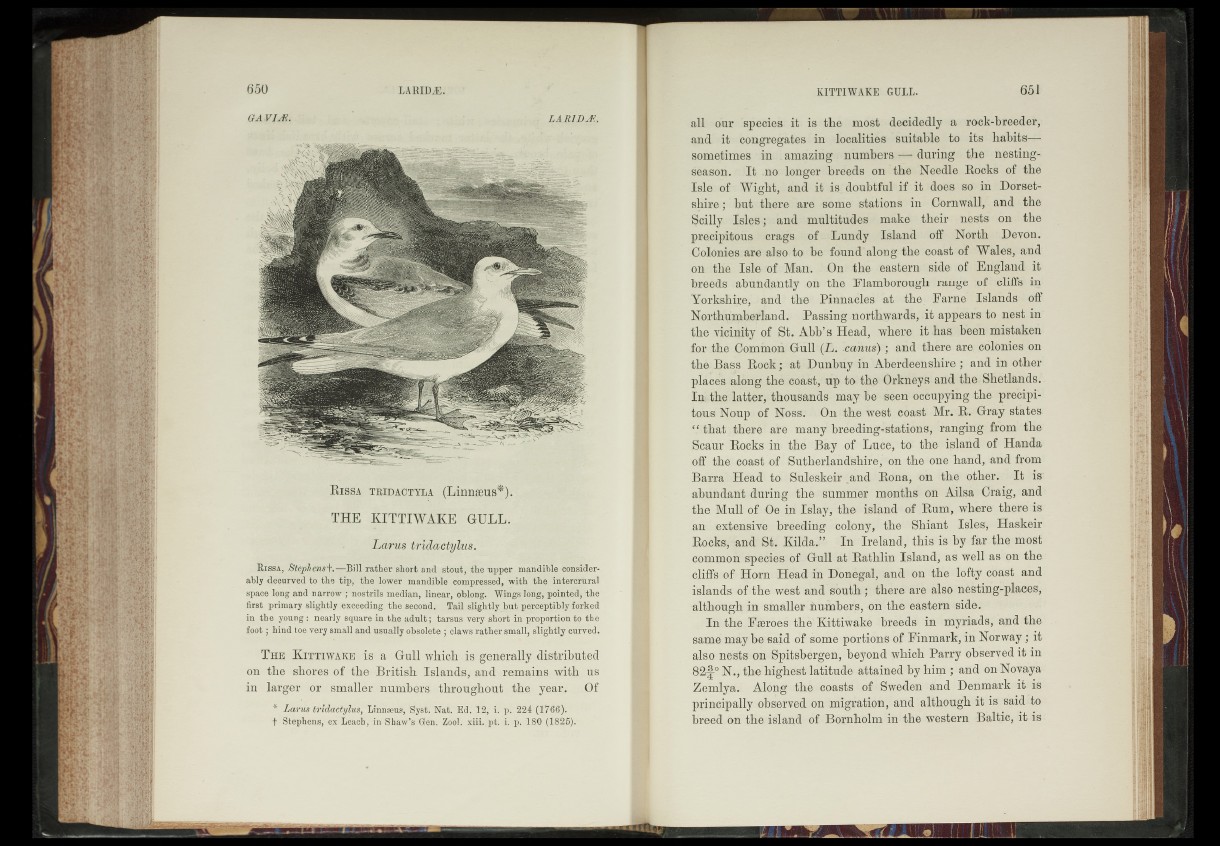
GAVI^E. LARIDJ?.
Rissa tridactyla (Linn,8eus*),f£
THE KITTIWAKE GULL.
' L otus trzdactylUs.'
Rissa, Stephens^.—Bill father ahoiii and „»the upper mandible'Considerably
decurved to the tip, 'the lower mandible eompressfid, with She -intererUral
space long and narrOw^Sc^^s median, line's^,' oblong.‘Wmgglo’flg, -pointed, the
first primary «lightly 'exceeding »the second^ Tail slightlyjbut perceptibly ^oiked
in the,, young,: nearly squpe^in,,theadultr^ tarsus very ebort in'proportion to tbe
foot; hind to,e very small and usually obsolete ; claws rath or small, slightly curved.
The KiTTiWAKE ' is- a fGull which-, is generally distributed
on tlie shores ofrthevBritish -Islands, and reg a in s witjj*-£s
In larger »or smaller number^ rttapoughout the y e ^ .j.-O f
* L a r u s VriiLactylus, L i n n a e u s , 224^(f7fi^i)T'i~p
t Stephens, ex-Leach,?'in Shaw’s -(Jea^&fe. xiiL^pt. 4. p. ,'1.80 (4,825,),*".'
ail dur species it- is the most decidedly a rock-breeder,
and it congregates£ in localities suitable to its hahits-^-
sometimes in. .amazing-- numbers.*^ during the nesting-,
season. -/It .no longer breeds on the Needle Rocks of the
Isle ®i;"Wight, and it iadoubtful-if it does so in Dorsetshire
; t hut. there are some stations in Cornwall/ and the
Soilly Ial'§&3“4>; and -multitudes mako-their- nests on the
precipitous erags of -Lundy Island off North Devon.
Colonar^siare also; to'he found’ alon g ib e ' coast of Wales, and
on the Isle of Man. On- the eastern ' side of England- It-
breeds abundantly on 'the Flamborough range 'of' cliffs in
Yorkshire, and the Pinnables a-t the Fame Islands off
Northumberland. Passing-northwards, flj| appears to nest in’
the vicinity of St. Abb’s Head, where it-has been mistaken
for the Common iMllf^;. and'there are colonies'on
the Bass Rock; at Du-nbiiy'-in'Aberdeenshire ; and in other-
placesalbng the coast, up to-thpJOrkneys, and the, Shetlands/
In* the latter/ thousands may be >-seem oefeupyihg the precipi--
tousbNaup- 'of Nose:. On the- west coast* Mr. R. Gray states
‘rtkat- there4 are many‘breedinglstafibnS, -ranging; from the
•Scaur Rocks iai’ 1^.e:-=Ba.y of -Luce, to the ipland of Handa
niff -tfeo/noast of Sutherlandshire, on the one Rand, and from
Barra' Head. t^#fclegkpi.*%and - Rena, ton -the other. It is*
ahdftdaMtfduring -the summer months on Alisa Craig, and
the Mull of iOe pn Islay, ti^ island of Rum, where' there is
an extensive, breedingM'colpn-y^rthe -Shiant Isles, Haskeir
Rocks,,iand:?Srt Kilda.-” ■Tn Ireland, thisus by far the most
common speciesfbMGiiM&tiR'athlin Island/.as well as on the
cjiffs iO&MesEh. Helad-jfn Donegal, and-on the^fety coast and
islands of the- west and south; there' are also nestihg^places,
-although in smaller hu-mber's, on the eastern side.
In?tbye.,lSseroes the - Eittiwake breeds in myriads, and the
same may be said of some portions of Einmark, in Norway f it
also, nests, on Spitsbergen, ,beyond'?vhioh Parry observed it in
8Q^° Nv, the-bigbOstiaititude attained'byhim ■; and on-Novaya
ZemlyaA. Along-»the coasts olb Swollen and Denmark it-is
principallylec&erved on .migration, and although-'it'is said-t©
breed, on the island of Bornholm in the western RkMe, it is